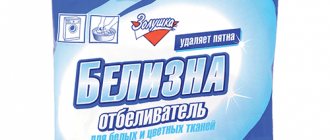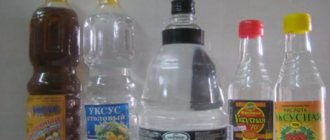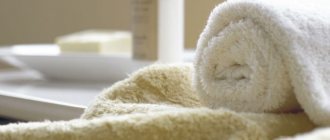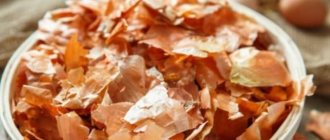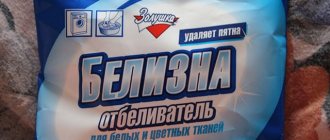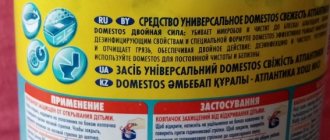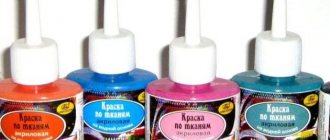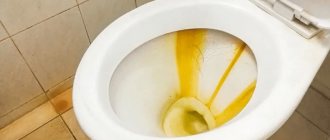In many cases, "Whiteness" for disinfection is the best option. This drug contains 8% active chlorine, therefore it is a powerful antiseptic and successfully fights most microorganisms. The basis of “Whiteness” is sodium hypochlorite. If you use it without exceeding the recommended proportion, then it cannot cause harm to a person.
It can be used for linen and dishes, floors and enamel baths. “Whiteness” is used to clean aquariums, water filters and wells. It is also indispensable in farmsteads - for disinfecting animal cages and their bedding.
Is Belizna suitable for disinfection and in what proportions should it be diluted?
In many cases, "Whiteness" for disinfection is the best option.
This drug contains 8% active chlorine, therefore it is a powerful antiseptic and successfully fights most microorganisms. The basis of “Whiteness” is sodium hypochlorite. If you use it without exceeding the recommended proportion, then it cannot cause harm to a person. It can be used for linen and dishes, floors and enamel baths. “Whiteness” is used to clean aquariums, water filters and wells. It is also indispensable in farmsteads - for disinfecting animal cages and their bedding.
Where to apply
Chlorine is suitable for cleaning and disinfecting absolutely any surface. Thanks to the powerful formula, the outer shell of even the most dangerous virus is destroyed in a matter of seconds. As a result, viruses and pathogens cannot cause harm and are unable to reproduce.
Chlorine is most often used for cleaning in hospitals, clinics, health centers and sanatoriums. With its help, not only the floor covering is cleaned, but also equipment and instruments of medical personnel. It is also used to clean restaurants, shopping centers, stores and other places with large crowds of people.
In everyday life, Whiteness is simply necessary for those who have dogs, cats, rodents, etc. It should also be used if there is a sick person in the apartment or office. Pets rarely become infected with viruses, but they can be carriers of them. That is why regular cleaning of premises is very important to prevent the spread of infection.
Almost everything in the house can be treated with whiteness. However, objects that a person (especially a child) often touches with their body or mouth are best wiped with a diluted product (1:10 with water). This is important to do in order to be sure that there are no skin reactions, allergies or poisoning.
Chlorine will also help cope with viruses on clothes and shoes, but there is usually no urgent need for its use. Viruses and other pathogens on things die during washing at water temperatures above 60 degrees. To enhance the effect, it is recommended to add a small amount of White to the washing powder.
Rules for using “Whiteness” in an apartment
Many housewives use this product to bleach fabrics and know the dosage. However, for disinfection, a solution of a different concentration is used: 60-100 ml of “Whiteness” per 1 liter of water. They can be used to wash dishes after an infectious patient, floors, washbasins and toilets.
A different method is used to disinfect sewer drains. At night, pour 1 liter of undiluted “White” into the toilet bowl or washbasin neck and close it with a stopper or lid. In the morning, wash off with plenty of water. This method allows you to get rid of both germs and unpleasant odors.
When working with “Whiteness”, do not forget about safety precautions - wear gloves. For prolonged contact or when using a concentrated solution, a respirator and safety glasses are required.
Instructions for machine and hand washing
Before bleaching towels, linen, and T-shirts, you need to take colored fabrics to another place so that drops of sodium hypochlorite do not fall on them. A spoonful of the product should be diluted in 3.5 liters of heated water and mixed with a soap solution. Place the items in the composition for a quarter of an hour, then rinse several times.
Whiteness is used for machine washing only when there is an inscription on the machine that allows the use of bleach. Before work, the drum is wiped with the composition, and if no reaction occurs, wet laundry is placed:
- Dissolve the liquid in the dosage specified in the instructions.
- Set the pre-wash mode.
- The program for the main cycle is selected with rinsing.
The amount of product depends on the volume of items to be bleached. For a small load, 50 ml of sodium hypochlorite is sufficient. The powder is added last.
If there are animals in the house
Sodium hypochlorite is an inexpensive, effective and easy-to-use product for cleaning and disinfecting pet litter boxes.
- You need to add 100 ml of “White” per liter of water.
- Rinse the tray with the resulting solution.
- After this, rinse it thoroughly.
It is enough to carry out this treatment once a week. The rest of the time, the “pot” is cleaned with ordinary detergent. If there are a lot of animals in the apartment and they leave marks, then “Whiteness” can perform the functions of both disinfection and deodorization. In this case, you need to treat the floor and walls (where animals mark them) with a weak solution (no more than 50 ml of “Whiteness” per liter of water). This type of cleaning should be done as often as possible.
Storage
Whiteness should be hidden from small children in inaccessible places. After opening, the solution retains its properties for six months: the active components gradually evaporate. The product loses its antiseptic and whitening properties. The manufacturer prohibits sending White to rooms with low temperatures (balconies, loggias): after the liquid freezes, its effectiveness decreases.
The universal product is intended for the destruction of bacterial and fungal pathogens in the apartment, cleaning floors, plumbing fixtures and tiles. Constantly used to add whiteness to clothes, bed linen, table napkins and towels. Application strictly according to the instructions helps with cleaning aquariums, houses and trays of pets.
Cleaning the water filter
Disinfection of filters in the “Reverse Osmosis” cleaning system with “White” is carried out when replacing cartridges.
Instructions for use
- After removing the cartridges and reverse osmosis membrane, you need to screw in the second and third flasks in the direction of water flow.
- The tube from the purified water tap is connected to the tee (instead of the carbon filter).
- 10 ml of “Belizna” is poured into the first flask and water is added, after which the flask is twisted.
- After 15-20 minutes, you need to open the water supply tap and the purified water tap.
- When the smell of chlorine is clearly audible from the purified water tap, close the taps and wait several hours.
- After this, the taps are opened again and water flows until the chlorine is completely washed out.
After this treatment, the filter is completely disinfected, you can insert the membrane and a new carbon filter.
Wash
How to bleach with white? In order for the item to acquire a snow-white appearance, you should perform the following steps:
- Pour cold water (10 liters) into a basin and add bleach (2 tbsp. L).
- Stir the mixture and soak the clothes.
- After 20 minutes, rinse.
- Wash things in the usual way.
To clean products made from dense materials, bleach should be applied to the stain, and after a minute, soak it in the solution. After this, things should be washed in the usual way. There is no need to soak clothes in boiling water, as this may impair the strength of the materials. After soaking, items should be rinsed several times with cold water.
"Whiteness" for cleaning the well
Chlorination in a well must be carried out in the correct proportions and strictly following the instructions for use.
- Pump out the water or scoop it out (at shallow depths).
- Clean the walls with a stiff brush.
- Prepare a solution: 600 ml of “Whiteness” per 10 liters of water.
- Treat the walls of the well and the upper superstructure along with the lid. This is best done with a spray bottle.
- After filling the well with water, the same solution is poured into it at the rate of 1 liter per 1 ring.
- Stir the water by lowering and raising the bucket.
- Cover the well head with polyethylene to prevent chlorine evaporation and leave for 6-10 hours.
- Pump out the water until the smell of chlorine disappears.
During disinfection, well water should not be used for drinking or cooking. After chlorination, it is recommended to boil it for 5-7 days.
We process white products and surfaces: rules of use
To quickly return snow-whiteness to your favorite things, and to do it at home, you don’t need to look for a newfangled remedy. Whiteness can solve this kind of problem. Here are some ways to use it correctly.
To maintain white color
Before washing, soak the laundry for 20 minutes in white.
- Pour 5 liters of cold water into a basin.
- Add 1 tablespoon of product.
- Stir the resulting solution well.
- Soak white items for half an hour.
- Rinse after the indicated time.
- Wash items on a normal washing cycle.
To eliminate gray or yellowish tints, stains of various origins
The processing process for white products is the same as in the first case. The only difference is to increase the soaking time to 1 hour.
Bleaching thick fabric
- Apply a small amount of undiluted product to the stain or stain.
- Hold for exactly 1 minute.
- Wash in the traditional way.
Frequent use of bleach will thin the fibers and lead to damage to the product. Everything is good in moderation.
To clean tiles, the solution is prepared as follows:
- Pour 5 liters of warm water into a container.
- Measure out 3 capfuls of chlorine solution.
- Stir thoroughly.
Apply the resulting solution to the surface of the sink, toilet or bathtub and leave for 15 minutes. Then rinse and rinse again. Cleaned products will shine with renewed vigor.
Aquarium disinfection
Sodium hypochlorite is often used to clean the aquarium of growths and microorganisms accumulated there. Moreover, the walls (glass) and decor are cleaned with a solution of varying concentrations.
Instructions for disinfecting aquarium decor
- 8-10 liters of warm water are poured into the container.
- Add 1 liter of “Whiteness” there.
- Immerse the aquarium decor in the solution and leave for several hours.
- After this, all elements are thoroughly cleaned and washed.
Decorative elements with a porous surface should be washed especially thoroughly, shaking out the remaining water from the pores. If this is not done, sodium hypochlorite will enter the aquarium and may negatively affect its inhabitants.
The aquarium glass is treated with a chlorine solution after cleaning the algae. This can be done in two ways.
- Apply the solution (dosage - 50 ml of “Whiteness” per liter of water) with a sprayer, trying to cover the entire surface. After a few hours, rinse the aquarium thoroughly with water.
- Pour the “White” solution into the aquarium and let it stand for 6 hours, then rinse thoroughly.
How to wash clothes with bleach
If you want to remove yellow stains or return your laundry to a snow-white color, you need to follow these steps:
- pour cold water (10 liters) into a basin and add bleach (2 tbsp);
- stir the solution and soak things in it;
- after 20 minutes, rinse the laundry and remove any remaining whiteness;
- Wash your items as usual.
To clean clothes made from thick fabrics, apply bleach to the stain, and after a minute, soak the items in the solution. After processing the products, wash them as usual.
Disinfection with white
Many housewives are interested in whether white can be used against mold that forms on the surface of the walls? The universal drug is effective against many microorganisms. To eliminate fungi, soak a sponge in the solution and then apply it to the surface. After the treated area has lightened, wipe it with a sponge one more time. Due to its high chlorine content, whiteness gets rid of mold on the walls and also prevents its subsequent appearance for some time.
The following method is suitable for disinfecting plumbing fixtures:
- pour a liter of white into the sink or toilet;
- cover the plumbing fixtures with a lid at night;
- In the morning, rinse the sanitary ware thoroughly with cold water.
What to do if whiteness accidentally gets on your clothes?
Bleach stains are quite difficult to remove, so you need to use it very carefully.
In addition, it is important to take precautions:
- Before carrying out the procedure, put on protective gloves;
- do not allow white to get into your eyes;
- limit children's access to the drug.
What to do if whiteness gets on your clothes and yellow spots form on them? There are several ways to effectively remove contaminants:
- hydrogen peroxide: soak a cotton pad in the product, wipe the stain with it, wash the clothes with the powder, and then rinse in cool water with conditioner (this method is effective when removing fresh small stains);
- Aspirin: crush two tablets, dissolve them in warm water and apply the mixture to the product, after two hours wash the clothes with powder (the method allows you to remove dirt that appeared more than three days ago);
- ammonia: add a teaspoon of product and salt (1 tsp) to water, soak the product in the solution for half an hour, and then wash it with soap (ammonia is effective in removing stains from silk, cotton and linen products).
Anti-coronavirus remedy for 20 rubles: use “Belizna” to disinfect your home
“Whiteness” for disinfection against coronavirus is one of the means recommended by the World Health Organization. It is suitable for processing residential and non-residential premises - houses, apartments, offices, warehouses, garages, even cars. It is available to all segments of the population, it is easy to buy in both big cities and small villages. And this is only part of its advantages.
Why is Belizna used for disinfection?
“Whiteness” is an aqueous solution of sodium hypochlorite. And since chlorine is invariably present in its formula, according to the laws of chemistry, when HPCN is combined with water, a certain amount of hypochlorous acid is formed. It has an amazing ability to kill all living things, including microorganisms - fungi, bacteria, viruses. Also, during the decomposition of hypochlorite, singlet oxygen is released, which mercilessly destroys any microflora.
Disinfection of various surfaces using “Whiteness” has a number of advantages, including:
- high efficiency - if all processing rules are followed, pathogenic microflora have no chance of surviving;
- low cost compared to other disinfectants - 1 liter of GPCN solution costs from 15 to 50 rubles (depending on the manufacturer and the presence of auxiliary additives in the composition);
- speed - on average, microorganisms die in 15–30 seconds;
- economical - even solutions with low concentrations of the active substance have bactericidal, virucidal and fungicidal properties.
A little history
In Ancient Egypt, in order to get beautiful clothes and bed linen, it was customary to bleach cotton. Since there were no chemicals intended for this purpose at that time, this procedure was carried out simply by aging the material under the rays of the sun. Later, other methods of bleaching both raw materials and finished items were used in different countries. Chemicals began to be used for this purpose only at the end of the 19th century. Sodium hypochloride turned out to be the most effective and inexpensive remedy. Compositions intended for whitening are still produced based on it. Including the well-known “Whiteness”, instructions for use of which will be discussed below.
How to dilute “Belizna” for home sanitation?
All you need to prepare the solution is a measuring cup or scale and a container in which to mix. “Belizna” can be diluted both immediately before use and for future use. The main thing is to store the prepared solution in a hermetically sealed container that does not allow light to pass through, for example, in a bottle or dark glass jar.
Whitening clothes
Soaking clothes
Manufacturers of the drug allow the use of whiteness for items made from cotton or linen material. Silk, wool, synthetic fabric with a pattern or dyed in bright colors will lose its appearance due to exposure to bleaching components.
You cannot use the solution on old things - an aggressive chemical reaction will destroy worn fibers and cause whitish spots to appear.
There are several methods for using chlorine-containing products:
- Getting rid of yellow, gray tint - 2 tbsp. l. Whiteness is diluted in 10 liters of liquid, things are soaked for 1 hour. After rinsing, put it in the washing machine. This method is not suitable for fabrics with a weak structure - the aggressive action of diluted bleach will destroy it.
- Stain treatment - used only on thick fabrics. The concentrated substance is poured onto the problem area, after a few minutes the product is rinsed. Longer exposure will result in discoloration and whitish spots. Washing is carried out in a machine at a temperature of 60 degrees.
- Preservation of snow-white color is achieved by soaking the laundry for 20 minutes. Pre-prepare a solution in the following proportion: 5 liters of cool liquid per 1 tbsp. l. facilities. After completing the procedure, the laundry is thoroughly rinsed and washed with powder to neutralize the smell and effect of the bleach.
Bleaching of bed linen, kitchen towels and small items can also be done in a machine. Before the procedure, you need to read the documentation for the device:
- the operating instructions should not contain prohibitions on the use of chlorine-containing substances;
- if the outlet tubes of the device are made of rubber, then it is better to refrain from washing - they should be plastic, and the drum should have anti-corrosion protection;
- when bleaching, you cannot set the mode with maximum temperatures - this tactic will harm both clothes and equipment;
- the product is not poured into the dispenser, but inside - it must be diluted beforehand;
- Before washing, the laundry is soaked in cold liquid.
Important! The recommended mode for the machine is with a pre-wash followed by a double rinse. When using it, there is no need to rinse things a second time.
Proportions for breeding “Whiteness”
“Belizna” itself is a ready-made aqueous solution containing sodium hypochlorite from 5 to 30%. As a rule, manufacturers do not indicate the exact concentration of HPCN, which can vary in different batches, so consumers can only guess what is splashing in each particular bottle.
In medicine, it is generally accepted that in the fight against viruses and other microorganisms, a 5% hypochlorite content is optimal. For this reason, “Whiteness” cannot be further diluted with water if there is a high probability that coronavirus is present on the surface being treated. These surfaces include:
- tableware (plates, cups) and cutlery (spoons, forks, knives);
- plumbing equipment (sinks, toilets, bathtubs, showers);
- other items made of porcelain, earthenware, glass, enamel and stainless steel that could come into contact with the biological fluids of a sick or potentially infected person (saliva, sputum).
To wash floors, walls, doors and door handles, household items, furniture, toys, shoe soles, “Whiteness” should be diluted with water in a ratio of 1:10 (100 ml of bleach per 1 liter of clean cold or slightly warm water).
To disinfect bed linen, reusable face masks, cotton handkerchiefs, towels - in the same proportion, but the soaking time should be at least 20 minutes.
The best bleach
Housewives have been using bleach for many years to give their linen the same white color. But you should use it in moderation: if you often use white on the same linen, then holes will soon form on it. In addition, you should not bleach synthetic items and delicate linen for the same reason.
This bleach can only be used on things that are white or any other fairly light color. Natural fabrics such as silk, wool and leather do not tolerate this chlorine-containing product, since even after one-time use of such bleach, the fabrics will acquire a yellow tint. But cotton and linen are quite forgiving of whiteness, as are fabrics with a low content of synthetic fibers.
You should not add this bleach to the washing machine: it will be better if you soak the laundry for 20 minutes in white before washing it, and then wash it in automatic mode.
What cannot be treated with “Belizna” against coronavirus?
Unfortunately, not all materials can be treated with chlorine bleaches. Since Whiteness has strong oxidizing properties, it will easily damage ferrous metals, especially steel and cast iron. After contact with rubber, rubber acquires a dirty yellow tint; foam rubber also loses color and begins to crumble. You should also not use it for sanitation:
- leather shoes and furniture;
- shoes with rubber soles;
- wool and silk products;
- electronic equipment (smartphones, laptops, keyboards, headphones, etc.);
- any items if the manufacturer’s instructions for them ask to exclude contact with bleach.
Whitening with baking soda
Baking soda is considered a fabric-safe bleach. Using this method, you can keep your favorite clothes in great shape for a long time, without fear of ruining them. Take 10 liters of warm water, add 10 tablespoons of baking soda and 5 tablespoons of ammonia. Dip your clothes into the resulting solution and leave for three hours. After this, wash as usual with washing powder.
The use of soda for bleaching is recommended for children's underwear, as it is absolutely safe and will not harm delicate skin. If soaking alone is not enough to get rid of stains and dirt, then you should boil it in the same solution for 30 minutes. You will have to spend time, but the result will be no worse than from bleaches that you can buy in the store. But keep the fabrics in their original form.
Safety regulations
Sodium hypochlorite and hypochlorous acid are dangerous not only for microbes, viruses and fungi, but also for humans. Therefore, when treating premises and objects against coronavirus, you should adhere to the following rules:
- Wear thick nitrile or latex gloves (GPCN greatly dries the skin of the hands, and with frequent contact makes the nails porous).
- To ensure a flow of fresh air - open a window (turning on the air conditioner is useless: it simply circulates the air in the room, cooling or heating it to a given temperature).
- Make sure that the solution does not get on the mucous membranes of the mouth, nose and eyes (if this does happen, you should immediately rinse the affected area with plenty of running water).
- Do not add “Whiteness” to hot water: high temperature provokes increased release of chlorine gas, which irritates the organs of vision and breathing, and also leads to poisoning.
- Remove pets and children from the premises.
Precautionary measures
The chemical composition of whiteness is quite aggressive, so when using the product it is important to follow the recommendations:
- Store out of reach of children, in a dry place, protected from direct sunlight at room temperature. After freezing, “Whiteness” completely loses its properties.
- Avoid contact of the product with eyes, mucous membranes and skin.
- Work with the product only with gloves. When used undiluted, wear a respirator and safety glasses.
- Do not mix the product with other chemicals, as the effect of the resulting composition on the skin, respiratory system, mucous membranes, and surfaces being cleaned is unpredictable.
- When cleaning rooms and cleaning surfaces, open windows. It is advisable that the children are not at home.
Life hack from the “experienced”: it is better to store a bottle of “Belizna” by placing it on its side, since if you hold the container on the bottom, after some time it will become problematic to unscrew the lid.
Before you handle “Whiteness,” you should protect the skin of your hands with rubber gloves.
Household poisoning with “Whiteness” is rare, but sometimes such cases do occur. Symptoms and first aid vary depending on the route of entry of toxic substances (see information in the table below).
Table: signs of poisoning and first aid
| Route of exposure to toxic substances | Symptoms | First aid |
| Inhalation of toxic fumes | Light form:
| The symptoms go away on their own within 24 hours, leaving no consequences. |
Medium form:
|
| |
Severe form:
| ||
Lightning Form:
| ||
| Contact with the mucous membranes of the eyes |
|
|
| Skin contact |
| Rinse the affected area with plenty of warm running water. |
| Entry into the gastrointestinal tract |
|
|
It is necessary to begin providing first aid measures even before the doctors arrive, following the recommendations that will be given over the phone. Medical assistance for any type of Belizna poisoning is required.
Instructions for the use of “Whiteness” for disinfection of premises
The world around us is filled with microorganisms. They can be:
- useful - have a positive effect on metabolism and processes in the body;
- harmful – cause diseases;
- opportunistic - at a normal level of immunity they have no effect, they are activated during a decrease in protection.
In order to prevent infection and spread of diseases, a set of measures is used to disinfect objects, hands and surfaces - disinfection. One of the main substances that destroy microorganisms is chlorine. The most affordable chlorine-containing preparation is “Belizna”.
Composition and release form of "Belizna"
“Whiteness” is a colorless transparent liquid with a pungent odor. It contains sodium hypochlorite, active chlorine, alkalis. These are caustic compounds that cause the death of many fungi, viruses and bacteria, so the product is actively used for disinfection in medical institutions, schools, and livestock farms.
The product can be purchased in the following forms:
- Pills. Dosed form of release, making it convenient to use. Requires dilution in water to obtain a solution, usually 1 tablet per 10 liters.
- Powder. Available in the form of bleach “Whiteness”. The main purpose is to add it during washing and disinfect things.
- Liquid. A popular and cheap option, you can find it in any chain store, hardware store or supermarket. The concentration of sodium hypochlorite in 1 bottle ranges from 5 to 15%, so the average content of the substance is considered to be within 10%.
- Gel. Thicker and more concentrated than liquid. Due to its viscosity, it lingers better on the objects and surfaces being processed.
Any type of “Whiteness” is suitable for disinfection. The instructions are indicated on the label and should be read before use, since in order to make a working solution, you will need different amounts of liquid, tablets or gel.
Indications for use
The product is excellent for disinfection, as it is active against many pathogens. It is used in diluted form, less often in pure form.
Examples of disinfection with ready-made or diluted “Belizna” - how to use it in an apartment or on the street:
- disinfection of the room, cleaning hard and soft surfaces from mold, viruses, microbes - for this you need to dilute the solution with water, the main option is 1 to 10;
- treatment of the greenhouse in the spring - remove old grass, pour the liquid into a container with a spray bottle, spray the supporting structures to prevent mold growth, the required concentration is 1 to 20;
- disinfection of sewage drains - a solution of 250 water and 250 ml of “Belizna” is poured into the sink or toilet and left overnight;
- bleaching, disinfecting things - soak in 5 liters of warm water, to which add 1 tbsp. l. products, then rinsed and washed; exposure time – up to 1 hour;
- disinfection of the chicken coop - 400 ml of the product is added to 10 liters of water, then the birds are removed from the cages or premises, sprayed, kept for 2 to 24 hours, washed off with a stream of water;
- cleaning the pool - drain the water, prepare a solution of 100 ml of “Whiteness” and 2 liters of water, wipe the side surfaces and bottom, then rinse it off with a hose;
- chlorination and disinfection of pool water - the product is added to the water at the rate of 0.3–0.5 g/m3, this is determined by special testers.
For the purpose of disinfection, “Belizna” can be used to wash floors, especially if there is a sick person in the house. To dilute it to protect against viruses, add 60 ml of the product to 1 liter of water. When the patient cannot leave the premises, the concentration is reduced by 3 times.
The liquid is poured into the washing machine to clean the system from mold and bacteria - the 2.5% solution is placed directly into the drum, not into the rinse aid compartment. Otherwise, parts of the device may be damaged.
To see how to prepare a product for treating an apartment against bacteria:
Contraindications for “Whiteness”
Disinfection should not be carried out if you are allergic to chlorine. The liquid is used with caution for bronchial asthma, especially of the allergic type.
Many people are stopped by the peculiar smell. Otherwise, there are no contraindications to disinfection with Belizna.
Directions for use and dosage
When working with Belizna, it is important to observe your own safety measures, otherwise disinfection may result in the provision of medical care:
- wear latex, rubber or nitrile gloves;
- work under the flow of fresh air - open the window, prepare the solution outside;
- for dilution, use warm or cold water; hot water will provoke the rare release of a large volume of chlorine vapor;
- carry out disinfection in the absence of children, animals and birds in the room.
Description, composition, properties
Varieties of whiteness
The product is produced according to GOST standards; it looks like a transparent liquid with a yellowish or greenish-yellowish tint. It includes:
- sodium hydrochloride - with active chlorine up to 95.2%;
- surfactants - to improve cleaning properties;
- caustic soda - softens the liquid, ensures alkaline balance.
The solution destroys contaminants at the molecular level due to oxidative processes. The composition of white does not allow unlimited use of it for disinfection and washing; permitted procedures include:
- removing various stains from colorless cotton and linen fabrics;
- bleaching bed and underwear;
- washing tiles, porcelain, enamel dishes;
- cleaning and disinfection of garbage containers, toilets, bathtubs, washbasins, aquariums.
Important! Manufacturers mask the repulsive aroma of the main ingredient with peach, lemon, pine, chamomile, apple and strawberry fragrances. It is made in the form of a gel-like mass or liquid solution.
